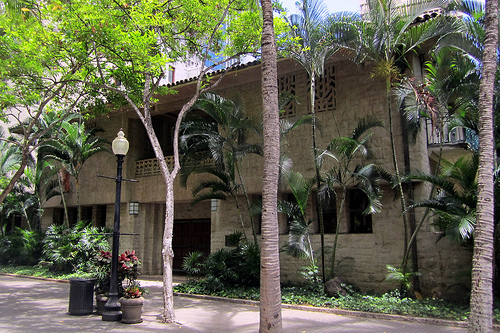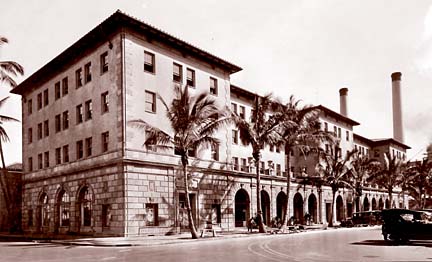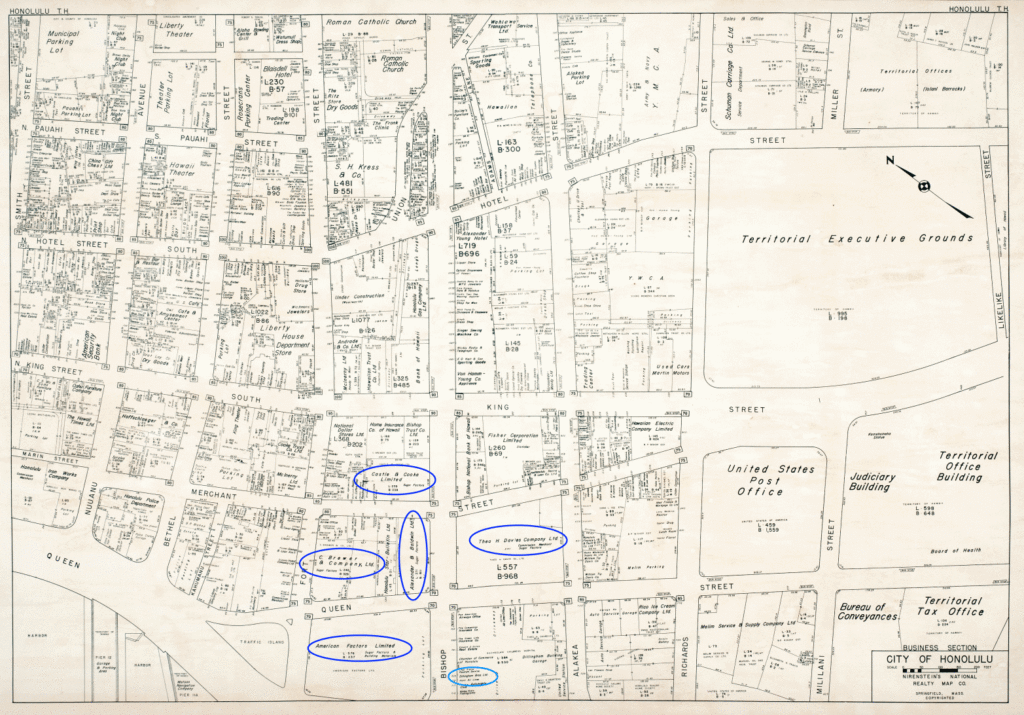Halekoa was a part of the ambitious building program undertaken by the Hawaiian monarchy in the 1860s and ‘70s. The buildings which remain today, besides Halekoa, are Aliiolani Hale (the judiciary building), the Royal Mausoleum, the old post office at the corner of Merchant and Bethel Streets, and Iolani Palace.
The site occupied by the barracks is doubly interesting, for it first accommodated the Chiefs’ Children’s School, which was begun in 1839 by Mr. and Mrs. A. S. Cooke, and which was moved in 1851 to the lower slopes of Punchbowl.
Theodore C. Heuck, a Honolulu merchant and gifted amateur architect from Germany, submitted his original plans on March 14, 1866, to John O. Dominis, then Governor of Oahu. The sketches provided for a structure with a frontage of 70 feet and a depth of 80 feet, built around a 30×40-foot open central court.
This was early in the reign of Kamehameha V. Years passed. Finally, early in 1870, the project began to move, although slowly. The post office was being built at the same time, and a shortage of proper workmen delayed both jobs.
Halekoa did not appear in the appropriations bills passed by the various legislatures. It was financed by the War Department as a part of military expenses, an cash as needed was deposited with the banking firm of Bishop and Company.
Foundations were being laid in May, 1870. J. G. Osborne was the builder. Participating suppliers included, among others, such well-known Honolulu houses as E. O. Hall and Son, Dowsett and Co., AS Cleghorn, Lewers and Dickson (predecessors of Lewers and Cooke, the Honolulu Iron Works, JT Waterhouse, H. Hackfeld and Co. (American Factors, AmFac) and Oahu Prison.
Halekoa was made of the ever-useful coral blocks hewn from the Honolulu reef. As often happened, many blocks were cannibalized from other structures, rather than chopped from the reef.
Most of the second-hand building blocks came from the wall fronting the old post office, and from the old printing office. But the reef had to yield up its treasures, too, and Marshal WC Parke received credit for 204 man-days of prison labor, at fifty cents a day, for the hauling of blocks therefrom.
By mid-February, 1871, both the barracks and the post office were nearing completion. Finishing touches on the former, however, required several more months.
An exotic example of this, among the accounts to be found today in the Archives of Hawaii, is a bill dated May 20, levying a charge of $12.50 for painting spittoons.
Even before it was completed, Halekoa was rushed into service. At the end of February a considerable number of soldiers were sick, and the new barracks was requisitioned as an infirmary.
Originally it was some 48 feet long. The size of the inner court was increased to approximately 34×54 feet, also. The side galleries were built longer than Heuck at first specified, because of the lengthening of the court, and about two feet narrower, because of the widening of the court, making them 18 feet rather than 20 feet in width.
Iolani Barracks displays a service record almost as complicated as its building alterations. The barracks was made originally to house the regular standing army of the Kingdom of Hawaii, the small force known in the early 1870s and before as the Household Troops.
Their function was to guard the palace, the prison, and the treasury, and to appear at various parades and ceremonies.
In September, 1873, the Household Troops mutinied. They barricaded themselves in Halekoa. After the mutiny the troops were disbanded, then later reorganized, and under one title or another they continued to occupy Halekoa throughout the remaining period of the monarchy.
Liliuokalani’s Household Guards, Captain Samuel Nowlein commanding, surrendered to the revolutionary Provisional Government about five o’clock on the afternoon of January 18, 1893.
The Guards were paid off and disbanded; the Provisional Government took over munitions stored in the barracks and at once occupied the building with a strong force. This government and the succeeding Republic of Hawaii used Halekoa to house their military.
After Hawaii was annexed to the US, President McKinley issued an executive order (December 19, 1899) transferring the barracks and the barracks lot to the control of the US War Department.
Thereupon, Halekoa was occupied by the Quartermaster Corps of the US Army and used for office and warehouse space. Quartermaster use continued until late in 1917, when the Corps moved out.
At that time the War Department planned to preserve Halekoa as a historic structure. For the first time in its long and colorful history, the old barracks ceased to be a station for soldiers.
In the summer of 1920 an elaborate remodeling job was in progress and it then served as a service club, with a dormitory added on the Waikiki side for visiting service personnel. The service club phase lasted about a decade.
November, 1929, found Governor Lawrence Judd trying to get President Hoover to issue an executive order returning the barracks to the Territory. The Hawaii National Guard wanted Halekoa for its headquarters.
Judd was successful, and the transfer took place officially on March 16, 1931. But the Hawaii National Guard did not benefit from it. Instead the barracks became the offices of the supervising school principals for Honolulu and Rural Oahu.
World War II came, and the Guard continued to use the aging barracks. Midway in that war (October, 1943) an imaginative postwar plan for Halekoa was announced. It was to become a military museum. Interested civic groups and individuals pledged to participate in planning and financing the project.
But the plans never materialized. The pressure for office space doomed Halekoa to a series of repairs, renovations, and remodelings as various government agencies succeeded one another in their occupancy of the barracks.
In November, 1960, Halekoa was embarrassed to find itself encumbering the site of a proposed multi-million-dollar state capitol. Although regarded in some quarters as an antiquarian nuisance, the barracks managed to cling to existence as officials delayed their decision regarding its disposition.
The above is taken from Richard Greer’s article on Halekoa in the October 1962 Hawaii Historical Review. It was written before Halekoa was relocated to make way for the State Capitol.
Click the link for Greer full article in the Hawaii Historical Review:
https://imagesofoldhawaii.com/wp-content/uploads/Halekoa-HHR-Revival-Greer.pdf
Here is the rest of the story …
Following Statehood, there were plans for the State’s new capitol building being considered. Architect John Carl Warnecke, son of a German-born father, was influential in the design and construction of the new capitol. (Warnecke also designed John F Kennedy’s grave site at Arlington National Cemetery, and lots of other things.)
Halekoa was in the way; the Barracks was condemned and, in 1962, abandoned. In 1964-65, to make room for the new capitol building, the coral shell of the old building was removed to a corner of the ʻIolani Palace grounds for eventual reconstruction.
This was accomplished by breaking out large sections of the walls. Then stone masons chipped out the original coral blocks and re-set them. Many were so badly deteriorated that they were unstable.
However, the stone in the ʻEwa wing (an addition to the original Barracks) was salvageable (they left that part out of the reconstruction, but used the material from it.) Today’s reconstruction bears only a general resemblance to the original structure. (NPS)
Several other older buildings in the area, including the large vaulted-roofed Armory and the remnant of the older Central Union Church on Beretania Street, facing the Queen’s former residence at Washington Place, were also demolished to make way for the capitol building.






























































